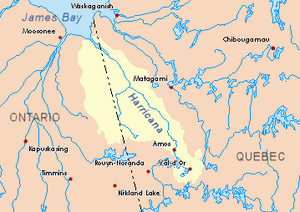Kadabakato River facts for kids
Quick facts for kids Kadabakato |
|
|---|---|

Harricana River basin in yellow
|
|
| Country | Canada |
| Province | Quebec |
| Region | Nord-du-Québec |
| Physical characteristics | |
| Main source | Unidentified lake Eeyou Istchee Baie-James (municipality), Nord-du-Québec, Quebec 289 m (948 ft) 49°27′29″N 78°47′59″W / 49.45806°N 78.79972°W |
| River mouth | Wawagosic River Eeyou Istchee Baie-James (municipality), Nord-du-Québec, Quebec 252 m (827 ft) 49°34′09″N 78°58′44″W / 49.56917°N 78.97889°W |
| Length | 27.9 km (17.3 mi) |
| Basin features | |
| Tributaries |
|
The Kadabakato River is a smaller river in Quebec, Canada. It flows into the Wawagosic River. This river is located in the Nord-du-Québec region, specifically in the area known as Eeyou Istchee James Bay. The Kadabakato River flows mostly through a forest area called the Estrées township.
The main activity in this region is forestry, which means cutting down trees for wood. After forestry, tourism and outdoor activities are also important. There are some forest roads that help people get around the area.
During winter, the river usually freezes over. It's typically safe to walk or travel on the ice from early December until mid-April. The ice usually forms by the end of November and melts by the end of April.
Contents
Where is the Kadabakato River?
The Kadabakato River is surrounded by other rivers and streams. Knowing these helps us understand where the river flows.
- To the north, you'll find the Wawagosic River, Turgeon River (Eeyou Istchee Baie-James), and Mistaouac River.
- To the east, there's Nekwackak Creek, Newiska Lake, and the Plamondon River.
- To the south, you'll see Brigaud Lake, Bruneau Creek, and more of the Wawagosic River.
- To the west, there's the Wawagosic River again and Obakamigacici Creek.
Starting Point of the River
The Kadabakato River begins from a small forest stream. This stream is located in the Estrées area. Its starting point is about 279 metres (915 ft) above sea level.
Here are some distances from its source:
- It's about 36.0 kilometres (22.4 mi) southwest of the village of Joutel.
- The river's mouth (where it ends) is about 17.9 kilometres (11.1 mi) to the southeast.
- The border between Ontario and Quebec is about 52.0 kilometres (32.3 mi) to the east.
- The mouth of the Wawagosic River is about 60.3 kilometres (37.5 mi) to the southeast.
How the River Flows
The Kadabakato River flows for about 27.9 kilometres (17.3 mi). It travels entirely through a forest.
Here's how its journey goes:
- For the first 5.1 kilometres (3.2 mi), it flows northwest in the Estrées township. It then meets a small creek coming from the southwest.
- Next, it flows 4.4 kilometres (2.7 mi) northwest to the outlet of Lac Brignaud.
- It continues for 10.9 kilometres (6.8 mi) northwest, winding its way to another creek coming from the north.
- Then, it winds southwest for 4.4 kilometres (2.7 mi) to the outlet of Lake Favreau, which comes from the south.
- Finally, it flows 3.1 kilometres (1.9 mi) northwest until it reaches its mouth.
Where the River Ends
The Kadabakato River ends by flowing into the southwest side of the Wawagosic River. This meeting point is also in a forest area.
Here are some distances to its mouth:
- It's about 44.7 kilometres (27.8 mi) southeast of where the Wawagosic River meets the Turgeon River (Eeyou Istchee James Bay).
- The Ontario-Quebec border is about 39.1 kilometres (24.3 mi) to the east.
- The mouth of the Turgeon River (Eeyou Istchee James Bay) is about 49.0 kilometres (30.4 mi) to the south.
- The village center of Joutel, Quebec is about 50.2 kilometres (31.2 mi) to the west.
What Does "Kadabakato" Mean?
The name "Kadabakato" comes from the Algonquin people, who are a First Nations group. In their language, "Kadabakato" means "we hear the sound of beavers striking with their tails." This suggests that beavers were common in this area.
The name "Kadabakato River" was officially recognized on October 5, 1982. This happened when the Commission de toponymie du Québec (Quebec Toponymy Commission) was created. This commission is in charge of naming places in Quebec.

